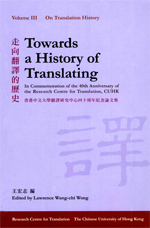Towards a History of Translating:
In Commemoration of the 40th Anniversary
of the Research Centre for Translation, CUHK
Volume II On Chinese Literature
走向翻譯的歷史
香港中文大學翻譯研究中心四十周年紀念論文集
Edited by Lawrence Wang-chi Wong
王宏志 編

| Table of contents | |
| Acknowledgements | 7 |
| 走向翻譯的歷史 王宏志 |
9 |
| 近代東亞語境中的文明和野蠻:以「野蠻」的詞史為中心 沈國威 |
37 |
| 廣智書局及其刊行的梁啓超譯著:以梁譯小說和史傳為中心 鄒振環 |
61 |
| 譯者的視角與傳播:片崗巖與東方孝義的臺灣民俗著述 楊承淑 |
105 |
The Inauguration of the Ming Dynasty: A Reappraisal of the Origin of the Dynastic Name and Related Fire Cosmic Symbol |
157 |
| Hayashi Razan's Vernacular Translations and Commentaries Peter Kornicki |
189 |
| Anthroposophy or Theosophy? A Preliminary Look at the Solomonic Judgment in Hebrew and Buddhist Canons Sher-shiueh Li |
213 |
| Translation as Self-Invention: Jin Shentan (1608–1661), Arcade Houange (1679–1716) and the Fashioning of a Transcultural Dicourse of Scholar-Beauty Ideals Patricia Sieber |
229 |
| Translation, Nationalism, and the Vernacular in the Development of East Asia Modernity Joshua A. Fogel |
277 |
| Barbarians or Not Barbarians: Translating Yi in the Context of Sino-British Relations in the Eighteenth and Nineteenth Centuries Lawrence Wang-chi Wong |
293 |
| "A Requisite of Such Vital Importance": The Want of Interpreters in the First Anglo-Chinese War (1839–1842) Uganda Sze Pui Kwan |
389 |
| Towards a Framework for Comparative Translation Historiography Judy Wakabayashi |
419 |
| Contributors |
467 |
Research Centre for Translation, The Chinese University of Hong Kong.